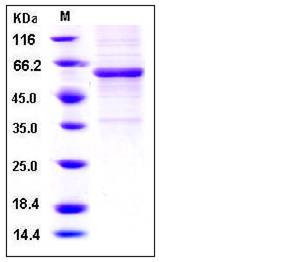Human METAP1 Protein (Fc Tag)
MAP1A,MetAP1A
- 100ug (NPP2340) Please inquiry
| Catalog Number | P10241-H01H |
|---|---|
| Organism Species | Human |
| Host | Human Cells |
| Synonyms | MAP1A,MetAP1A |
| Molecular Weight | The recombinant human Fc/METAP1 is a disulfide-linked homodimeric protein. The reduced monomer consists of 509 amino acids and has a predicted molecular mass of 57 kDa. As a result of glycosylation, the apparent molecular mass of rh Fc/METAP1 monomer is approximately 60-65 kDa in SDS-PAGE under reducing conditions. |
| predicted N | Glu 20 |
| SDS-PAGE |  |
| Purity | > 85 % as determined by SDS-PAGE |
| Protein Construction | A DNA sequence encoding the N-terminal domain (Met 1-Phe 272) of human METAP1 (NP_055958.2) was fused with the Fc region of human IgG1 at the N-terminus. |
| Bio-activity | |
| Research Area | Signaling |Signal Transduction |Metabolism |Pathways and Processes |Metabolic signaling pathways |Amino acid metabolism | |
| Formulation | Lyophilized from sterile PBS, pH 7.4 1. Normally 5 % - 8 % trehalose and mannitol are added as protectants before lyophilization. Specific concentrations are included in the hardcopy of COA. |
| Background | Processing of the N-terminal initiator methionine or formylated methionine is an essential cellular process conserved from prokaryotes to eukaryotes. The proteolytic removal of N-terminal methionine from nascent peptides is catalyzed by a family of enzymes known as methionine aminopeptidases (MetAPs) and is essential for cell growth. METAP1 and METAP2 have different substrate specificity due to the differences in both size and shape of the active sites. As a member of the M24 family of metalloproteases, METAP1 plays an important role in G(2)/M phase regulation of the cell cycle and may serve as a promising target for the discovery and development of new anticancer agents. |
| Reference | 1. Lowther, W.T. and B.W. Matthews, 2000, Biochim. Biophys. Acta. 1477: 157 – 167. 2. Addlaqatta, A. et al., 2005, Biochemistry. 44: 14741-14749. 3. Hu, X. et al., 2006, Proc. Natl. Acad. Sci. U.S.A. 103:18148-18153. |
